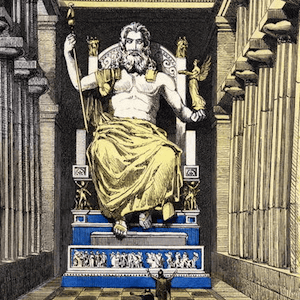Hellenistic Structures > Seven Wonders of the Ancient World
Seven Wonders of the Ancient World
Background
The Seven Wonders of the Ancient World refers to a set of ancient buildings and monuments that were deemed to be the most ornate, elaborate and marvelous structures above all else. These Seven Wonders were listed in many of the guidebooks that were popular among the Greek Hellenistic Period travelers between 200 BCE and 100 BCE which has led some researchers appropriately name them the "Seven Wonders of the Hellenistic World". It is believed the origins of this list are around the 3rd century BCE as this is one of the only times all seven of these structures could have possibly co-existed.
The most notable guidebooks and quite possibly the origins of the idea came out of the city of Sidon by a man named Antipater or from a Greek named Philo out of the city of Byzantium which would later become Constantinople. Regardless of who originally made it the list has been copied and passed down so many times it is impossible to tell who really came up with the idea. As for the wonders themselves, only the Great Pyramid of Giza has survived the test of time with nearly all the Greek wonders and the Hanging Gardens of Babylon being completely destroyed.
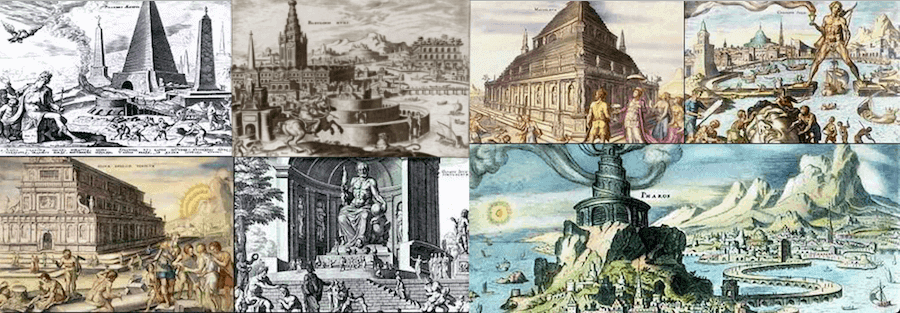
Seven Wonders of the Ancient World - Maarten Heemskerck (1572)
The idea of the Seven Wonders was to showcase the structures that were the largest, most culturally significant and best feats of engineering. Despite their splendor and grandeur, the Colossus of Rhodes, Pharos Lighthouse and Mausoleum of Halicarnassus were destroyed by violent earthquakes and the Temple of Artemis at Ephesus and the Statue of Zeus at Olympia were both destroyed on purpose. The Hanging Gardens is a true mystery with some speculating it did not exist, others in a different city and while some claim it was in Babylon right where everyone said it was.
Overall the idea of the Seven Wonders of the Ancient World has captivated people for countless generations and has inspired countless more to grab a backpack and travel the world to see what else is out there. Recently updated to the modern world, the Seven Wonders of the Modern World feature many great works built by mankind in the last several hundred years.
Origins
Following Alexander III the Great's conquest of the Achaemenid Empire, the known world opened up to the people of Greece. While history focuses on the exploits of the leaders and generals themselves, the list of the Seven Ancient Wonders of the World really gives insight into the ancient travelers and explorers of the day. Throughout the late 300's and 200's BCE the civilizations of Persia, Egypt and Babylonia really became accessible to Greek travelers who did not have to fear for their safety going into hostile lands for the first time in hundreds of years.
In doing so the Greeks were marveled at the various cultures and structures they saw throughout the new world that had been opened up to them. Eventually after time passed the best and most recognized wonders of the ancient world stuck in the minds of the Greeks who were known to have been great fanatics about culture and architecture. The ancient Greeks did not call these structures wonders but instead named them theamata which means sights or things to be seen in the Greek language.
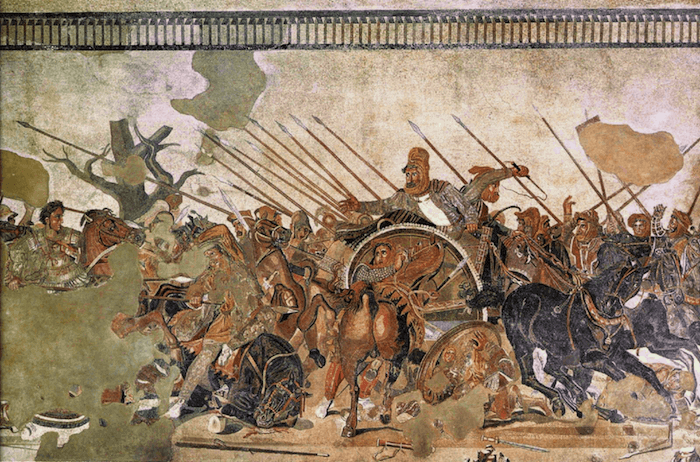
Battle of Issus Mosaic - 100 BCE
In antiquity there existed several different Seven Wonders lists but the most famous became that of Antipater of Sidon which emerged around 140 BCE. His list did not include the Pharos Lighthouse and added the Walls of Babylon, which contained the great Ishtar Gate. He was believed to have also cited Herodotus (484 BC–ca. 425 BC) and Callimachus of Cyrene (ca. 305–240 BC) which would have been housed at the Library of Alexandria at the time and have been the inspiration for his work. His list contained all of the six other ones we have come to recognize and know. Quoting the Greek Anthology IX:58 the list of Antipater of Sidon was as follows:
"I have gazed on the walls of impregnable Babylon along which chariots may race, and on the Zeus by the banks of the Alpheus, I have seen the hanging gardens, and the Colossus of the Helios, the great man-made mountains of the lofty pyramids, and the gigantic tomb of Mausolus; but when I saw the sacred house of Artemis that towers to the clouds, the others were placed in the shade, for the sun himself has never looked upon its equal outside Olympus."
The true origins of the list however, can only be attributed to a very short range of time if we are to assume the original author had indeed traveled to and seen all of the structures still intact. The best evidence for this is given by the Colossus of Rhodes which was built in the early 280 BCE and only lasted a few decades before getting destroyed by earthquakes in 226/225 BCE. This would mean the original list was compiled within a few decades of Alexanders death after the Wars of the Diadochi had sorted out the various kingdoms to begin with.
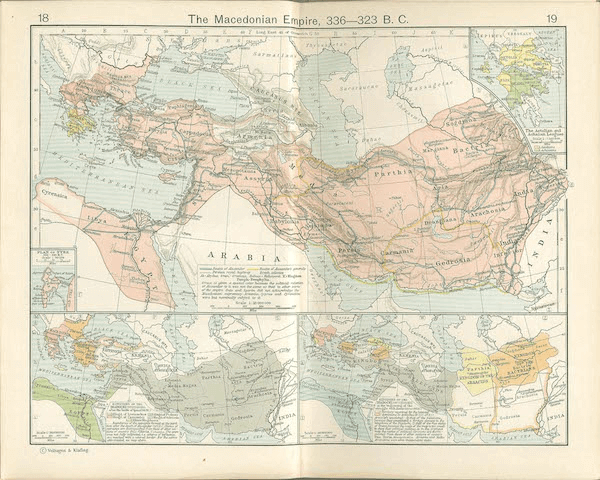
Macedonian Complete Empire Map - Historical Atlas (1923)
Despite the period of waring factions within Alexander's old empire, many of the aristocratic and wealthy Greek travelers along with scholars and philosophers could adventure all through the Seleucid Empire, Ptolemaic controlled Egypt and the other Greek controlled Hellenistic kingdoms to explore all the wonders on this list.

Kingdoms of the Diadochi Map - Historical Atlas (1923)
Another list is given by the mathematician Philo from Byzantium who recorded a short account of the worlds wonders in his piece The Seven Sights of the World. His incomplete manuscript only covered six of the seven wonders that all corresponded with the same ones in Antipater's list.
List of Wonders
Here is the following list of world wonders as commonly accepted by most historians. We have also included many other great structures worthy of this list at the bottom. Overall, every ancient structure is grand in its own way as they give a great insight into the culture and architecture of the past. These wonders are picked for their splendor and grandeur above all the rest and will continue to inspire mystery for centuries to come. The wonders are listed in order of age of creation.
Great Pyramid of Giza
The Great Pyramid of Giza is an Egyptian structure that is the oldest and only one still standing from this list. This is because the Great Pyramid of Giza was built using earthquake prevention technology whereas none of the Greek structures incorporated this into this engineering. While typically attributed to the ruler Khufu there is no direct evidence linking him to the construction of this structure. Yet, archaeologists insist this massive 2 million stone block structure was built within a 25 year time period when smaller sized structures around the world took even longer.
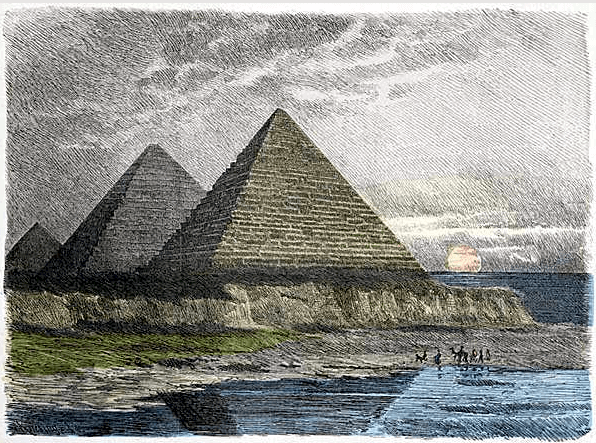
Great Pyramid of Giza - Ferdinand Knab (1886)
While also typically thought of as a tomb or monument there are no inscriptions anywhere within the Great Pyramid to suggest this and there has never been a mummy found within. The dimensions of the Pyramid are no coincide and each block appears to be handcrafted and unique. Overall, there are more questions and mysterious about the Great Pyramid of Giza than there is evidence and answers. Until all avenues of investigation are explored with regard to this great and ancient structure, we may never know all the secrets it holds.
Hanging Gardens of Babylon
See Hanging Gardens of Babylon
The Hanging Gardens of Babylon were a massive structure that was built in the ancient city of Babylon by the Chaldean King Nebuchadnezzar II of Babylonia. They were believed to have been a great terraced garden that contained plants and trees from all over the world, arranged beautifully overlooking the city. It is hard to pinpoint just one wonder in the city of Babylon because there are several. In fact, the city itself was probably one of the most important in all of ancient history. It was seen as a deeply religious city of great reverence and importance.

Hanging Gardens of Babylon - Ferdinand Knab (1834-1902)
Archaeologists continually debate over weather the Hanging Gardens existed at all, with some believing they are wrongly attributed to Babylonia. Yet there are quite a few events that lead us to reconsider this hypothesis. Until the city of Babylon is full excavated, these gardens will remain as much of a mystery to us as they have for the last millennium.
Temple of Artemis at Ephesus
The Temple of Artemis at Ephesus was a great and marvelous structure that existed on the eastern shores of the Mediterranean Sea throughout much of ancient history. It was built in the civilization of Lydia at the ancient city of Ephesus. Lydia was an independent kingdom in the Greek controlled region of Anatolia. The actual site of the Temple itself has been built over and destroyed many times throughout its history with its original origins believed to go back to a meteorite impact.
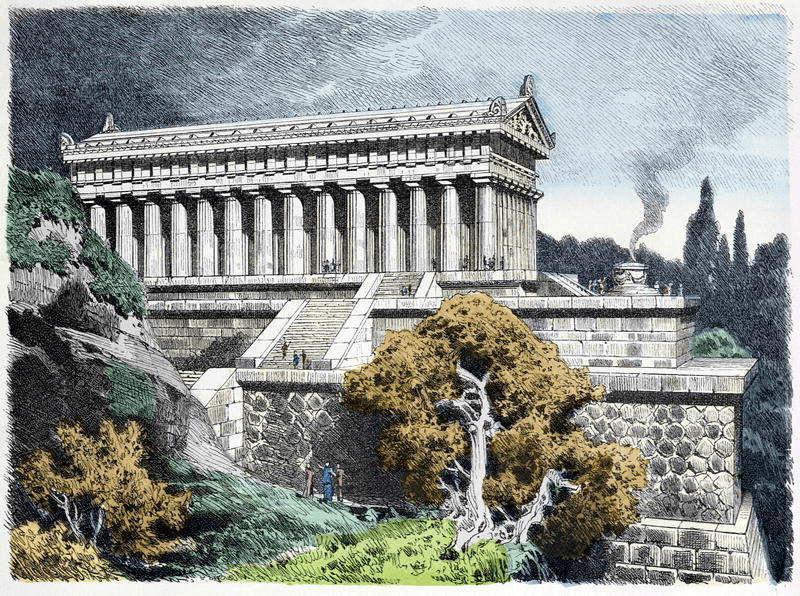
Temple of Artemis at Ephesus - Ferdinand Knab (1886)
The Temple is famous for being burnt down on the same night that Alexander III the Great was born and has been home to many unique and various sects of pagan religions throughout its history. The common conception of the Temple seen depicted on the Seven Wonders list was created by the famous Greek architect who also would later be commissioned to build the Mausoleum of Halicarnassus. In the ancient world, the Temple of Artemis was a place of deep religious significance and was one of the most beautiful and oldest columned temples in all of the Greek world.
Statue of Zeus at Olympia
The Statue of Zeus at the Greek city of Olympia was one of the Seven Wonders of the Ancient World and also one of the largest statues created in honor of the Greek gods. It was a massive statue to the Greek god Zeus that was made of gold and ivory over a wooden frame model. It was seated on a cedar throne that was sculpted with great reliefs and adorned with precious stones and ebony. The statue of Zeus was one of the most revered of the Structures and one of the most elaborate.
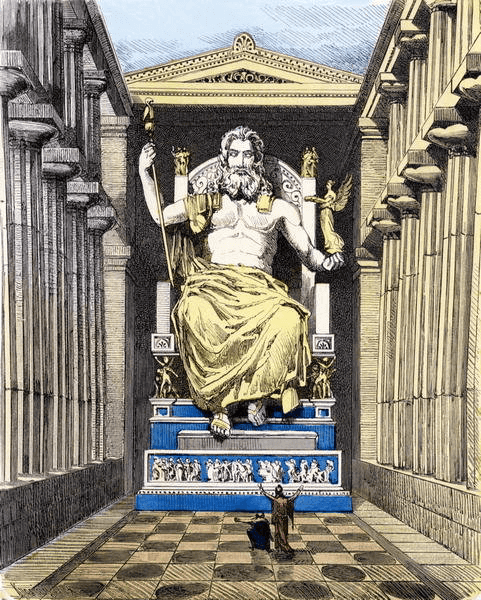
Statue of Zeus at Olympia - Ferdinand Knab (1886)
Built in the legendary city that hosted the Greek Olympics the entire games were a massive festival and celebration of Zeus. People from all over Greece would come to participate in the festival and no doubt stopped at the massive Temple of Zeus to make an offering before this magnificent statue. Eventually looted for a private collection and destroyed, this wonder has unfortunately been lost to history. Yet its legacy will always live on in the form of one of the unusual statues ever conceived for the first American president.
Mausoleum of Halicarnassus
The Mausoleum of Halicarnassus was a magnificent tomb created for the king of Caria and like the Colossus has come to actually influence modern language. The term mausoleum has come to refer to any great tomb for a member of the elite or a ruler and can be directly traced back to this structure. This magnificent tomb was built by Artemisia I of Caria who was the wife of king Mausolus following his death and its construction employed some of the greatest sculptors in all of Greece to complete.
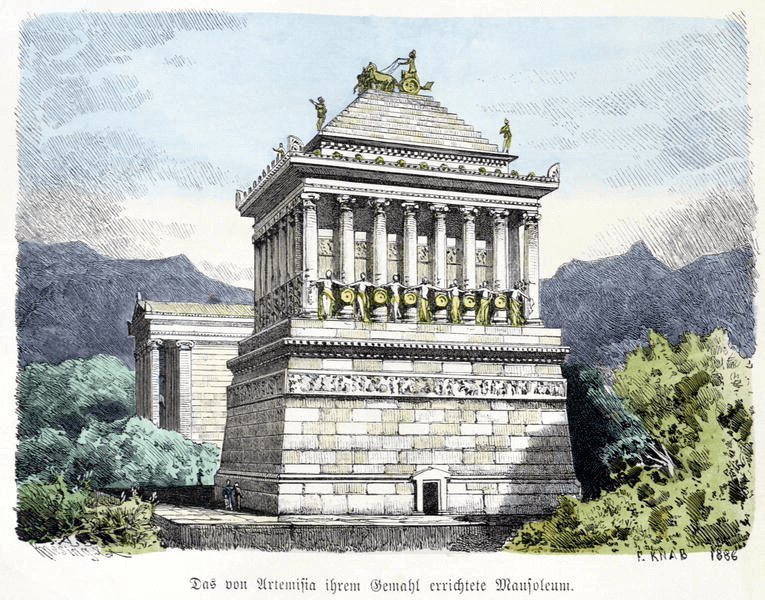
Mausoleum of Halicarnassus - Ferdinand Knab (1886)
Standing several stories tall this massive tomb was adorned with the greatest reliefs and statues in all of the Aegean region. It would come to define the ancient city of Halicarnassus and would greatly influence the architecture of many later ancient tombs and modern buildings. It was one of the longest surviving structures before being destroyed by earthquakes and eventually used as building materials to make a Crusader-era castle.
Colossus of Rhodes
The Colossus of Rhodes was the largest bronze statue constructed in the ancient world at the Greek island city-state of Rhodes. It was created following the unsuccessful Siege of Rhodes of the Wars of the Diadochi during which the fleeing invaders dropped all their weapons and equipment outside of the city. The people of Rhodes salvaged or sold off all the weapons in order to fashion a statue of the god that helped protect them.

Colossus of Rhodes - Ferdinand Knab (1886)
Thus the wonderful Colossus of Rhodes was born and has served as the inspiration for countless structures since. Giving rise to the term "colossus" meaning any grand statue, this massive statue stood guard over the harbor at Rhodes for over fifty years before being destroyed by an earthquake. Told by the oracles not to rebuild it, the statue lay on the ground for hundreds of years and continued to impress all travelers to the island who remarked upon the splendor of its size.
Pharos Lighthouse at Alexandria
The Pharos Lighthouse was a massive structure built in the city of Alexandria in Egypt under the leadership and vision of Alexander III the Great along with the Library of Alexandria after he conquered the Achaemenid Empire and liberated the satrapy of Egypt. The Pharos Lighthouse was a massive functional structure that helped guide boats into the safe harbor of the city.
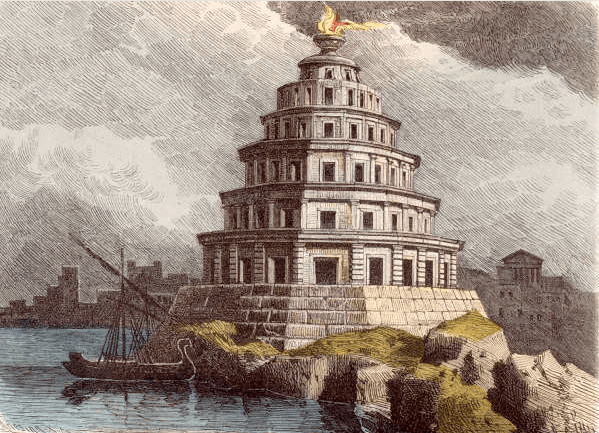
Pharos Lighthouse - Ferdinand Knab (1886)
The lighthouse would survive for many centuries before being destroyed by a series of earthquakes. Its final destruction was documented by the fabled traveler Ibn Battuta and leaves us with many mysteries regarding its design and architecture. There have been no pieces recovered from the lighthouse and the foundations are believed to currently reside underneath a modern structure. Overall it was one of the tallest structures in the ancient world and sure to impress anyone that was entering the great Hellenistic port city of Alexandria at the time.
Overview
| Structure | Construction | Civilization | City | Builder | Destruction | Cause |
| Great Pyramid of Giza | Unknown | Egypt | Giza | Unknown | N/A | Limestone & Capstone Gone |
| Hanging Gardens of Babylon | c. 600 BCE | Babylonia | Babylon | Nebuchadnezzar II | 100 CE | Unknown |
| Temple of Artemis at Ephesus | 550 BCE & 323 BCE | Lydia | Ephesus | Unknown | 356 BCE & 262 CE | Arson & Plundering |
| Statue of Zeus at Olympia | 435 BCE | Greece | Olympia | Unknown | 500 - 600 CE | Unknown |
| Mausoleum of Halicarnassus | 351 BCE | Caria | Halicarnassus | Artemisia I of Caria | 1500 CE | Successive Earthquakes |
| Colossus of Rhodes | 292–280 BCE | Greece | Rhodes | Rhodians | 226 BCE | Earthquake |
| Pharos Lighthouse | c. 280 BCE | Egypt | Alexandria | Alexander III the Great | 1480 CE | Successive Earthquakes |
Artistic Representations
Maerten Heemskerck
Ferdinand Knab
Fischer von Erlach
Modern List
Recently there was a massive worldwide vote held in order to determine the newest Seven Wonders of the World.
Seven Wonders of the Ancient World
Sources
- Acra
- Alexandria Structures
- Antigonid Structures
- Antioch Structures
- Arcadian Gate At Messene
- Bam Citadel
- Belevi Mausoleum
- Caesareum Of Alexandria
- Canopic Way
- Cleopatras Palace At Alexandria
- Colossus Of Rhodes
- Craterus Ex Voto
- Delos Synagogue
- Dura Europos Church
- Edicts Of Ashoka
- Esaggila
- Etemenanki
- Ex Voto Of The Attalids
- Filippeios Krini
- Fortifications Of Demetrias
- Fortifications Of Derbent
- Fortress Of Acrocorinth
- Gates Of Alexander
- Great Library Of Antioch Destruction
- Great Library Of Antioch
- Great Pyramid Of Giza
- Gyaur Gala Fortress
- Hanging Gardens Of Babylon
- Heliodorus Pillar
- Hellenistic Arches
- Hellenistic Architecture
- Hellenistic Columns
- Hellenistic Hydraulic Structures
- Hellenistic Libraries
- Hellenistic Monuments
- Hellenistic Ornaments
- Hellenistic Temples
- Ishtar Gate
- Kapilikaya Rock Tomb
- Library Of Alexandria Destruction
- Library Of Alexandria
- Library Of Pergamon Destruction
- Library Of Pergamon
- Machicolations
- Mausoleum At Halicarnassus
- Monument Of Prusias II
- Monumental Gateway Of Antioch
- Necropolis Of Alexandria
- Oracle At Delphi
- Pergamon Altar
- Pergamon Structures
- Persian Royal Road
- Pharos Lighthouse At Alexandria
- Philippeioi
- Philippeion
- Ploutonion At Hierapolis
- Poliorcetics
- Priene Inscription
- Ptolemaic Baris
- Ptolemaic Structures
- Pyramid Of Hermel
- Royal Palace Of Antioch
- Royal Tombs At Vergina
- Sanctuary Of The Great Gods
- Sebasteion Of Aphrodisias
- Seleucid Structures
- Serapeum
- Seven Wonders Of The Ancient World
- Statue Of Zeus At Olympia
- Temple Of Apollo At Daphne
- Temple Of Apollo At Didyma
- Temple Of Artemis At Ephesus
- Temple Of Artemis At Sardis
- Temple Of Athena Polias At Priene
- Temple Of Dendera
- Temple Of Edfu
- Temple Of Kom Ombo
- Temple Of Melqart
- Temple Of The Nymphs
- Temple Of Zeus At Olympia
- Temple Of Zeus At Seleucia Pieria
- Theater Of Dion
- Theater Of Epidaurus
- Tomb Of Alexander The Great
- Tomb Of Cyrus The Great
- Tomb Of Juba II
- Tomb Of Midas
- Tomb Of Philip II
- Tombs Of The Kings Of Pontus
- Tumulus Of Kasta Hill
- Walls Of Alexander
- Walls Of Babylon
- Walls Of Messene



